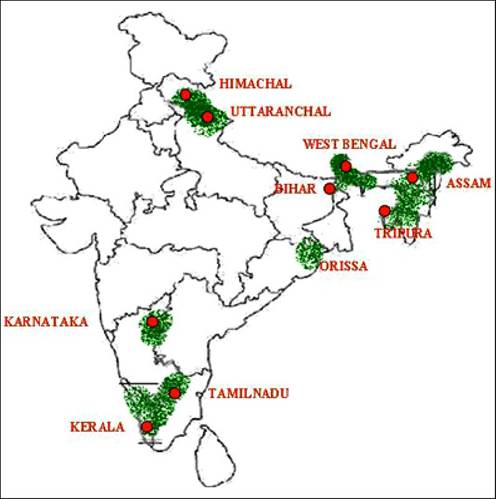Why is it in News?
- Persistent heat, delayed rainfall, high humidity continue into November, disrupting Assam’s traditional post-monsoon cooling.
- Unpredictable weather causing wilting, blackening, and irregular flush cycles, hitting productivity and quality.
- Climate change + stagnant prices squeezing margins of tea growers and estates.
- New research using 50 years’ climate data + IPCC RCP 2.6 & 4.5 models shows suitability decline by 2050, forcing tea cultivation to shift to higher altitudes.
- Tea tribes (a major workforce constituency) becoming a key factor ahead of Assam 2026 elections.
Relevance:
GS1 – Geography
- Climate–crop interactions; temperature/rainfall variability.
- Regional vulnerability: floodplains, monsoon dependence.
GS3 – Environment & Agriculture
- Climate impacts on productivity, quality, pest outbreaks.
- Modelling (RCP scenarios) → future suitability shifts to higher altitudes.
- Adaptation technologies: irrigation, clonal varieties, agroforestry.
GS2 – Governance / Social Issues
- Tea tribes’ socio-economic vulnerability.
- Labour rights, health impacts, political relevance ahead of 2026 elections.

Tea Basics — The Science of the Crop
- Optimal temperature: 13–28°C, best growth at 23–25°C.
- Optimal rainfall: 1,500–2,500 mm, evenly distributed.
- Soil: Acidic (pH 4.5–5.5), deep, well-drained, high organic matter.
- Growth pattern: Continuous but in flush cycles, driven by temperature + moisture.
- Quality determinants: Flavour and aroma depend on slow growth, cool nights, and predictable rainfall.
What Climate Change Is Doing to Assam’s Tea
Temperature
- Mean minimum temperature rise of 1°C over 90 years → destroys night-time cooling needed for flavour compounds.
- More days >35°C → nutrient absorption falls; leaves wilt.
Rainfall
- Winter & pre-monsoon rainfall declining → poor early-season flush.
- Monsoon rainfall becoming erratic → flooding + soil nutrient leaching.
- ~200 mm annual rainfall loss over 90 years → chronic moisture stress.
Seasonality Shift
- Heat lingering till November → mismatched harvest cycles, disease risk rises.
Pests & Diseases
- Warmer, more humid conditions → explosion of red spider mite, tea mosquito bug, blister blight.
- New pest behaviour observed after night temperatures rose.
Impact on Tea Quality
- Reduced polyphenol and flavonoid formation → weaker aroma, lower global competitiveness.
Economic Stress: Weather Gets Worse, Prices Don’t Improve
- Tea auction price rise: only 4.8% per year for 30 years.
- Staples like wheat/rice: ~10% annual price rise.
- Real returns stagnant → growers cannot invest in new clones, irrigation, or R&D.
- Rising input costs: labour, energy, agrochemicals, logistics, irrigation.
- Ageing bushes (40–60 years old) + no funds for replantation → productivity stagnation.
Why Assam Tea Is Especially Vulnerable
- Grown in floodplains, not hills → hydrological stress higher.
- Monoculture plantations → low ecosystem resilience.
- High labour dependence → wages rise but productivity does not.
- Climate-sensitive product where quality directly follows weather cycles.
Social & Political Dimensions
- 12 lakh workers, majority women → highest climate vulnerability.
- Increased heat stress, mosquito-borne disease risk, water shortages.
- Wages stagnant, living conditions poor → climate shocks hit hardest.
- With elections due in 2026, tea tribes are emerging as a decisive political constituency.
- Issues gaining traction:
- Rising cost of living
- Poor housing & healthcare
- Climate-driven drop in working days
- Stagnant wages
Adaptation Pathways — What the Industry Is Trying
Agronomic Solutions
- Drought-resilient clonal varieties + seed-grown plants with deep roots.
- Mulching, cover cropping → retain soil moisture.
- Agroforestry → shade trees reduce heat, stabilise microclimate.
- Organic amendments → rebuild soil carbon.
Water Management
- Micro-irrigation, sprinklers, drip systems.
- Rainwater harvesting for dry patches.
- Drainage redesign to handle sudden downpours.
Pest Management
- Integrated Pest Management (IPM)
- Biological controls, pheromone traps, precision spraying.
Supply-Chain Reform
- trustea (India Sustainable Tea Code)
- 1.4 lakh small growers verified
- 6.5 lakh workers covered
- Focus on efficient water use, safe agrochemicals, shade cover, soil health.
Structural Reforms Needed
- Policy parity: treat tea as agriculture, not an industry only.
- Income diversification for estates:
spices, fruits, agri-tourism, livestock, fisheries, direct-to-consumer sales. - Investment in climate forecasting, early-warning systems.
- Subsidised replantation, drip irrigation, and disaster-compensation schemes (like MSP-linked crops).
Big Picture — The Tea–Climate Paradox
- Assam produces 50%+ of India’s tea and drives a $10 billion economy.
- Climate is becoming harsher just as global tea prices stagnate.
- Domestic labour, logistics, compliance costs rising → margins collapse.
- Without decisive adaptation + policy support,
India risks losing global leadership in premium tea.



